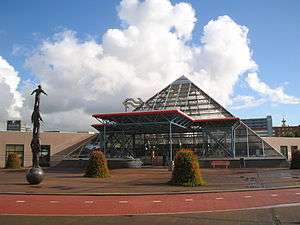Rijswijk
Rijswijk (/ˈraɪsvaɪk/ RYSSE-vyke, Dutch: [ˈrɛisʋɛik] (![]()
Rijswijk Ryswick | |
|---|---|
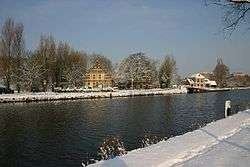 | |
 Flag .svg.png) Coat of arms | |
.svg.png) Location in South Holland | |
| Coordinates: 52°2′N 4°19′E | |
| Country | Netherlands |
| Province | South Holland |
| Government | |
| • Body | Municipal council |
| • Mayor | Michel Bezuijen (VVD) |
| Area | |
| • Total | 14.49 km2 (5.59 sq mi) |
| • Land | 14.05 km2 (5.42 sq mi) |
| • Water | 0.44 km2 (0.17 sq mi) |
| Elevation | 0 m (0 ft) |
| Population (January 2019)[4] | |
| • Total | 53,467 |
| • Density | 3,805/km2 (9,850/sq mi) |
| Demonym(s) | Rijswijker |
| Time zone | UTC+1 (CET) |
| • Summer (DST) | UTC+2 (CEST) |
| Postcode | 2280–2289 |
| Area code | 070 |
| Website | www |
The municipality also includes the villages 't Haantje and Sion.
History
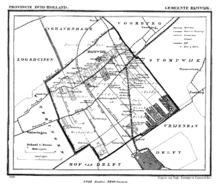
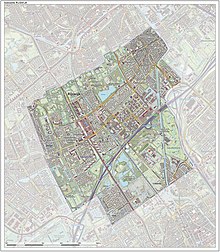
Archeological excavations indicate that this area of the coastal dunes was already inhabited some 5500 years ago. The formation of the village Rijswijk took place in the 13th century, and its history was dominated by presence of mansions and estates of the nobility and affluent. Among the many country estates known to have been in Rijswijk are:
|
|
The Treaty of Ryswick was signed at the Huis ter Nieuwburg in 1697, ending the Nine Years' War. A monument, the Needle of Rijswijk (1792), was erected to commemorate the treaty in the Rijswijk Forest.
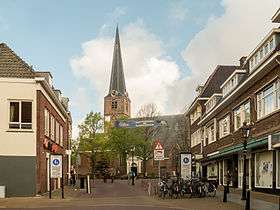
Until 1900 Rijswijk remained a relative small community but it became urbanized during the 20th century when it expanded rapidly. Today, Rijswijk's area has almost been completely built-up. The last major development is the new Ypenburg neighbourhood, built on the lands of the former Ypenburg Airfield but this part of Rijswijk was annexed by The Hague in 2002. Rijswijk is part of the Haaglanden conurbation. During the years its built-up area has grown to the point where it has effectively merged with The Hague, even though it is still a separate municipality.
Up until 2009 Rijswijk had a polytechnic college for applied sciences; TH Rijswijk (Technische Hogeschool Rijswijk). After a merger with the Haagse Hogeschool, this was moved to the campus of the TUDelft in Delft. The building still remains.
Istana Negara, one of the six presidential palaces of Indonesia, in the Jakarta neighbourhood of Harmoni (formerly Rijswijk-Molenvliet), was called Palais te Rijswijk during Dutch colonial times.
Economy
Rijswijk is home to:
- The Biomedical Primate Research Centre (BPRC).
- The Netherlands Patent Office, at the same location as the Dutch branch of the European Patent Office.
- A large technology centre of the oil company Shell, on Kessler Park.
- A small part of the Dutch national Forensic Laboratory, researching clues and objects in order to aid police investigations. The main building is moved to The Hague-Ypenburg.
Recreation
- Wilhelminapark
- The Von Fisenne Park has a petting zoo.
- Sports park 'De Schilp' has an indoor swimming pool.
- Museum Rijswijk located at Herenstraat 67, 2282 BR Rijswijk has many works of art
The largest shopping center is called 'In de Bogaard' and smaller shops are located in the old town center (Herenstraat). There is the old Schaapweimolen (windmill). De Broodfabriek holds many fairs and events.
Notable residents
.jpg)
.jpeg)
Public thinking & Public Service
- Dionysius Koolen (1871–1945) a Dutch politician
- Henk Beernink (1910 – 1979 in Rijswijk) a Dutch politician
- Chris van Veen (1922–2009) a politician; also worked for the municipality of Rijswijk 1945/1960
- Gerard Veringa (1924 – 1999 in Rijswijk) a Dutch politician and criminologist
- Maurits Kiek (1909-1980) resistance fighter World War II
- Johan van Benthem (born 1949) former academic logician
- Albert Benschop (1949-2018) a Dutch sociologist and academic
- Peter Oskam (born 1960) a Dutch politician, former football referee and judge
- Sigrid Kaag (born 1961) a Dutch politician and diplomat, Minister for Foreign Trade and Development since 2017
The Arts
- Adriaen van der Cabel (1630–1705) a Dutch Golden Age landscape painter
- Hendrik Tollens (1780 – 1856 in Rijswijk) poet
- P. J. Cosijn (1840–1899) a Dutch scholar of Anglo-Saxon literature
- Jacques van Meegeren (1912–1977) a Dutch illustrator, painter and suspected art forger
- Teddy Scholten (1926–2010) a Dutch singer and winner of the 1959 Eurovision Song Contest
- Felix Thijssen (born 1933) author of crime and science fiction novels and books for children
- Peter Slaghuis (1961–1991) a Dutch musician, DJ, producer and remixer
- Ilja Leonard Pfeijffer (born 1968) a poet, novelist, polemicist and classical scholar
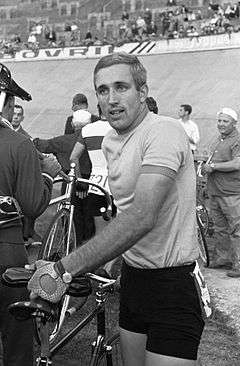
Sport
- Louis Otten (1883–1946) football player, team bronze medallist at the 1908 Summer Olympics
- Piet van der Touw (born 1940) a retired cyclist, competed at the 1960 and 1964 Summer Olympics
- Richard Knopper (born 1977) a Dutch former footballer with 285 club caps
- Anish Giri (born 1994) a Russian-born Dutch chess Grandmaster, lives in Rijswijk
- Keye van der Vuurst de Vries (born 2001) a Dutch basketball player, made his debut for the Netherlands national basketball team aged 16
References
- "Burgemeester" [Mayor] (in Dutch). Gemeente Rijswijk. Retrieved 20 August 2013.
- "Kerncijfers wijken en buurten" [Key figures for neighbourhoods]. CBS Statline (in Dutch). CBS. 2 July 2013. Retrieved 12 March 2014.
- "Postcodetool for 2284DP". Actueel Hoogtebestand Nederland (in Dutch). Het Waterschapshuis. Retrieved 20 August 2013.
- "Bevolkingsontwikkeling; regio per maand" [Population growth; regions per month]. CBS Statline (in Dutch). CBS. 1 January 2019. Retrieved 1 January 2019.
External links
| Wikimedia Commons has media related to Rijswijk, South Holland. |
